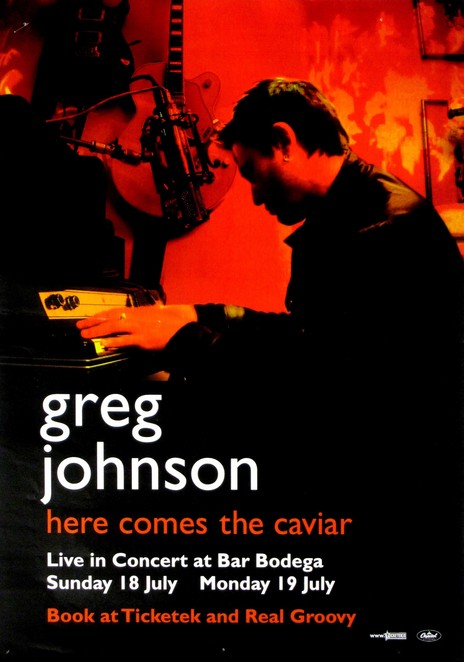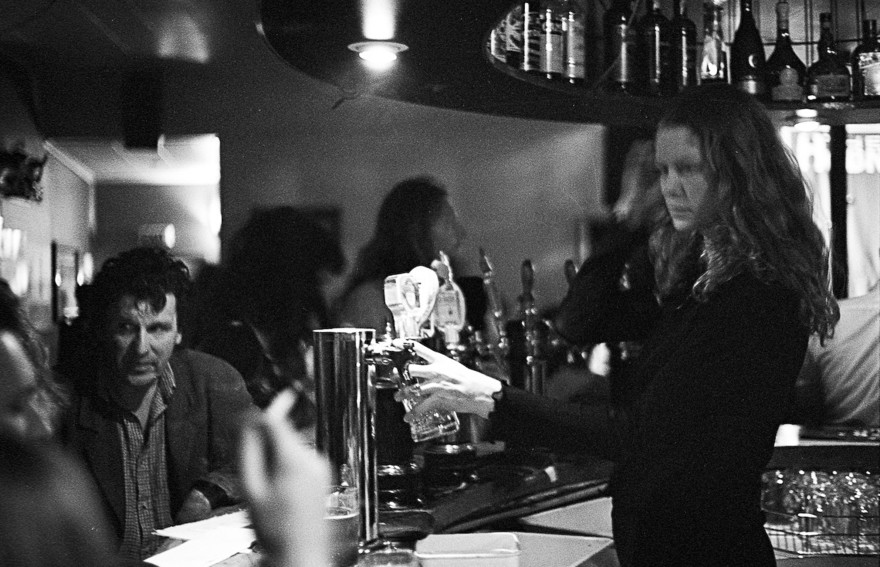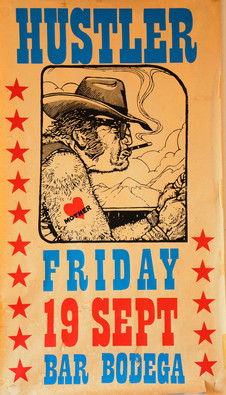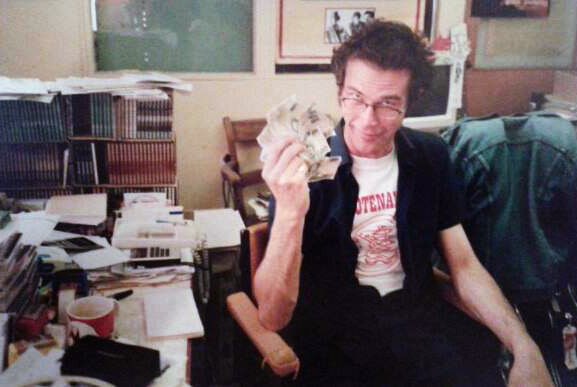The opening in 1991 of the original Bar Bodega on Wellington’s upper Willis Street spawned a thriving alternative music scene in the early to mid 90s. It was centred around an unlikely, yet somehow perfect, venue and an encouraging proprietor: Fraser McInnes. Many distinctive and often short-lived bands played there on a regular basis.

Bar Bodega, on the corner of Willis and Abel Smith streets, Wellington, 1990s. - Chris Chapman
My first recollection of the old Bar Bodega was seeing This Will Kill That, who made a beautiful din. I remember being impressed that they had a recording which I promptly bought and wore out. It was on cassette which was the standard medium for local bands self-releasing their own music. Many of these cassettes could be found at Solid Air Records, a tiny hole in the wall shop owned by John Pilley near the corner of Vivian and Cuba St. John took our first EP release, Bilge Festival’s Baby Monk Girl, and I remember going in nervously once a week or so to see if he had sold any copies.

Bar Bodega, from behind the bar. - Horst Puschmann
Other memorable acts I saw early on at Bodega included the Brothers Gorgonzola featuring a charismatic frontman called Francis Tunnicliffe. Francis later became an absolute fixture at many Bodega gigs and he also authored the infamous Frankman strip which appeared in the weekly gig guide pamphlet Engine.

Frankman T-shirt release party with Brothers Gorgonzola, Bar Bodega, 1991; art by Francis Tunnicliffe.
The “old Bodega” – as those who regularly attended or played gigs there will attest – was the type of imperfect venue that for all sorts of reasons shouldn’t work, but did anyway. Its smaller size and very low stage made gigs feel more like playing at a party in someone’s living room, albeit one that had a bar with great beer and some always interesting goings-on either inside or out. As well as the main bar, Bodega’s entrance corridor and the alley out the back door were always remarkably social spots in all respects.
The bar capacity was around 180 or so at a pinch – 100-120 was better – but even with around 50 noisy and enthusiastic types a band could get something going with an audience.

Fraser McInnes, Bar Bodega. - Horst Puschmann
A great advantage of the venue was its position in upper Willis St, just on the perimeter of the central city but still near to residential flats in town and its adjacent city suburbs such as Aro Valley and Brooklyn. Unlike other venues which seemed to empty out quickly once a band finished, Bodega would stay busy until late, with people still drinking and milling about. Even after a band’s crowd slowly started to thin out it would add to its numbers later on with batches of new patrons dropping in on their way home to the local neighbourhoods from other bars and clubs, knowing it was still likely to be sociable well after midnight.
Bodega’s strength was that it fulfilled the need of the classic neighbourhood pub, in that regardless of what was going on or whatever time you dropped in, it was likely you would probably bump into someone you knew. Even picking up your band gear early in the afternoon the next day when the regular cleaner Bob was in, you could find yourself chatting away, Fraser would come by and you might have a beer or three and then you would be there the whole afternoon.

Crowd photo at Bar Bodega, Wellington. - Ian Jorgensen
It attracted a wide range of people, from students to a contingent of older regulars who kept vigil at the bar in the afternoon or early evening. The music was varied, with acts playing anything from jazz to punk.
In 2016, former bar manager Sukhita Langsford told RNZ’s Kirsten Johnstone about the amazing collection of regulars she poured pints for. “We’d have plumbers and builders, and musicians and bank managers, and clergy. The minister from the church down the road. It was such a varied group of people and I guess we all enjoyed sitting there having a beer and a chat trying to solve the problems of the world.”
Bodega began as a café – La Bodega – in an old Edwardian shop at the corner of Willis and Abel Smith Streets. Fraser McInnes and co-owner Steve Jinks extended the building out the back, with the aim of bringing together alternative beer with alternative music. It was an active scene just waiting for a centre.

Fraser McInnes, Bar Bodega. - Horst Puschmann
Bar Bodega’s sound was courtesy of a rudimentary vocal PA with the instrumental sound coming direct from the amplifiers on stage. Due to the size of the venue this actually worked well with the benefit of it rarely being too loud, regardless of who was playing.

Greg Johnson at Bar Bodega in 2004.
Thus another factor in Bodega’s appeal to bands was its ease of set up. No tedious and boring soundchecks that lasted all afternoon. All that was required was to set up your gear on the stage, check the vocal microphones worked, play a minute or two of a song, ask anyone handy if it sounded okay and you were good to go. The aforementioned regulars wouldn’t have put up with much more anyway. A long hard stare from their vicinity at the bar let you know you better make it quick.

Barry Saunders at Bar Bodega; Sukhita Langsford pours a pint. - Horst Puschmann
Booking a show at Bodega was a rather casual affair consisting of catching Fraser early in the week and consulting a large wall planner in his upstairs office with a loose consultation around dates. From that point, promotion of a gig was either a limited number of small posters around town – that may or may not have gone up in time – plus word of mouth, the gig guide on Radio Active or a blackboard out front on the street. The band room or “green room”, where you tuned up or wrote set lists, was often in one of the rooms of the flat above the bar (where Fraser lived for a time, often coinciding with when his dinner was on).

CD tray insert from the debut album by The Stereo Bus, first released by Beats Bodega Records, 1997.
Some of the local bands from that period that we played with included: Short (who were actually quite tall), Cowcatcher, Letterbox Lambs, Gun Of Sod, (ex Skeptics – Robin Gauld’s solo turn) and the intriguingly named Thrust Reverser Access Panel.

Poster for a 1997 Bar Bodega gig by Wellington band Hustler.
A by-product of the music scene that developed through Bar Bodega was the record label, Beats Bodega Records. CDs released under the label include the debut albums by Short, Cinematic and the Stereo Bus.
There were other larger band venues around town that we played, such as the James Cabaret in Mt Vic, and the various incarnations of the current San Fran at 171 Cuba St (The Cave /Ali Baba’s/Sonic Temple). Bodega was however for several years the most constant, knowing it was where we most enjoyed performing and that it was likely lots of people we knew would show up.
A key figure around Bodega at that time was Andrew Tolley. His numerous musical outfits included Jawload, Sow Puss, Hustler, and The Hasselhoff Experiment. A friendly and unassuming character and also highly productive, Andrew appeared to have a new and equally good band every few months. He also ran Kato Records, initially as New Zealand distribution for overseas labels such as Estrus and Crypt, bringing in a range of loud primitive rock ranging from trashy garage punk to swamp psychobilly. Kato later released vinyl for New Zealand groups of a similar aesthetic such as Ape Management, The Strap Ons, The Scuzzbuckets, Baconfoot, Flaming Werepigs and others.

Andrew Tolley, Kato Records, 1998.
A number of the Flying Nun bands active at that time seemed to find a second home at the bar, appreciating Fraser’s affability and Bodega’s low key nature: the ease of playing there and the crowd proximity suiting bands such as The 3Ds, Snapper, King Loser, Solid Gold Hell, etc.
Chris Knox in particular was a semi regular over the years – undoubtedly in his element due to the venue providing the opportunity to get down and dirty with the audience, and apparently appreciating Bodega’s “greasy patina”.

Chris Knox at Bar Bodega, Wellington. - Horst Puschmann

Fraser McInnes and Chris Knox, Bar Bodega. - Horst Puschmann
International acts also played. Legendary gigs included Will Oldham backed by The Renderers, and The White Stripes before their profile expanded. Also, The Dirty Three, where the audience, while witnessing a blinding gig, were also entertained between songs by Warren Ellis’s dry wit and shaggy stories that could stretch out for minutes at a time, while his bandmates wore a patiently resigned look.
McInnes told Johnstone that his anthropology degree was useful to his work as a publican. “I basically just built a culture. The culture also came from the locals, it came from being in Aro Valley, it came from the musicians, the alternative lurkers from upper Cuba St from the period.”
Bodega also came of age alongside Wellington’s emerging late night café scene pioneered by the likes of Midnight Espresso in upper Cuba St which, in the early 90s, was also in its prime. After gigs if we were kicked out of Bodega we would make our way just down the street still buzzing on alcohol and adrenalin. Fortified by Midnight Espresso’s infamous special coffees (strong long blacks with generous slugs of whisky) we could carry on well into the small hours.

Bilge Festival poster, Bar Bodega, Wellington.
The location had many issues that helped create the Bodega scene, but also were a portend that its stint as a music destination would be temporary. The building was in a transitional area between the CBD and inner residential homes, so noise control problems inevitably arose. Also, with the inner-city bypass a constant threat over the building’s survival, rent was cheap. But the controversial bypass would eventually carve its way through bohemian upper Cuba Street.
McInnes told Johnstone that the threat of the bypass meant there was a fleeting nature about the Bodega that gave it an edge. “I remember Transit NZ came and said ‘Fraser, we want you to move up to Dransfield House, we’ll sell you the building [lease] for a dollar. I stupidly said no.’” (Dransfield House, further up Willis Street, was a Victorian mansion built in about 1876 for Wellington’s first mayor; by the 1990s it was in a sorry state.)

JP, a regular at Bar Bodega during the 1990s. - Horst Puschmann
The slow creep of the bypass’s construction meant the days of the Willis Street location – and the scene it stimulated – were numbered. New premises were found nearby on Ghuznee Street: a busy thoroughfare leading to the bypass. The new location was in a building that housed the Brasserie Flipp restaurant in the early 1990s.
In 2005 McInnes, his staff, and several of the Bodega regulars picked up the horseshoe-shaped bar and walked it around the corner to Ghuznee Street. “We had bagpipes up the front and a New Orleans jazz band at the back,” he told RNZ. “It was pretty cool. That was the culture of it.”
But new liquor licensing laws had an effect on the bar take, and smokefree regulations grated with McInnes. He decided to move on, though he will always be regarded as the godfather of the Bodega scene.
It was just such a wonderful time in Wellington’s history,” he told Johnstone. “Craft beer was on the rise, the bands that we had were really good, and so it was quite rich. That community meeting place isn’t in bars as much as it used to be.”
--

Jitterati on Bar Bodega, by Grant Buist, Capital Times, 2005. Alexander Turnbull Library, Wellington; Ref DCDL-0008244

Jitterati on Bar Bodega, by Grant Buist, Capital Times, 2002. - Alexander Turnbull Library, Wellington; Ref DCDL-0008044.
Bye Bye Bodega: RNZ’s Kirsten Johnstone on the closure of the Bodega, 2016
Farewell Bodega: Murray Hepple, co-owner of the Bar Bodega, talks to RNZ’s Kathryn Ryan about its final weekend.
--
Thanks to Nick Bollinger, Stu Brown, Jules Desmond, Brett Garrity, Kirsten Johnstone, Andrew Tolley.